Introduction
- The project’s topic: catheter-associated urinary tract infections (CAUTIs).
- The presentation’s goal: collation of evidence for the project.
- Method:
- analysis of articles (8);
- their comparison/contrasting;
- finding connections between them and the project/practice.
This presentation contributes to the description of a quality improvement project which focuses on the reduction of catheter-associated urinary tract infections (CAUTIs). The presentation’s goal is to offer a summary of the evidence that has been collected over the past few weeks during discussions. A total of eight high-quality articles have been selected, and their analysis and comparison will allow making conclusions that will be of use to the project.
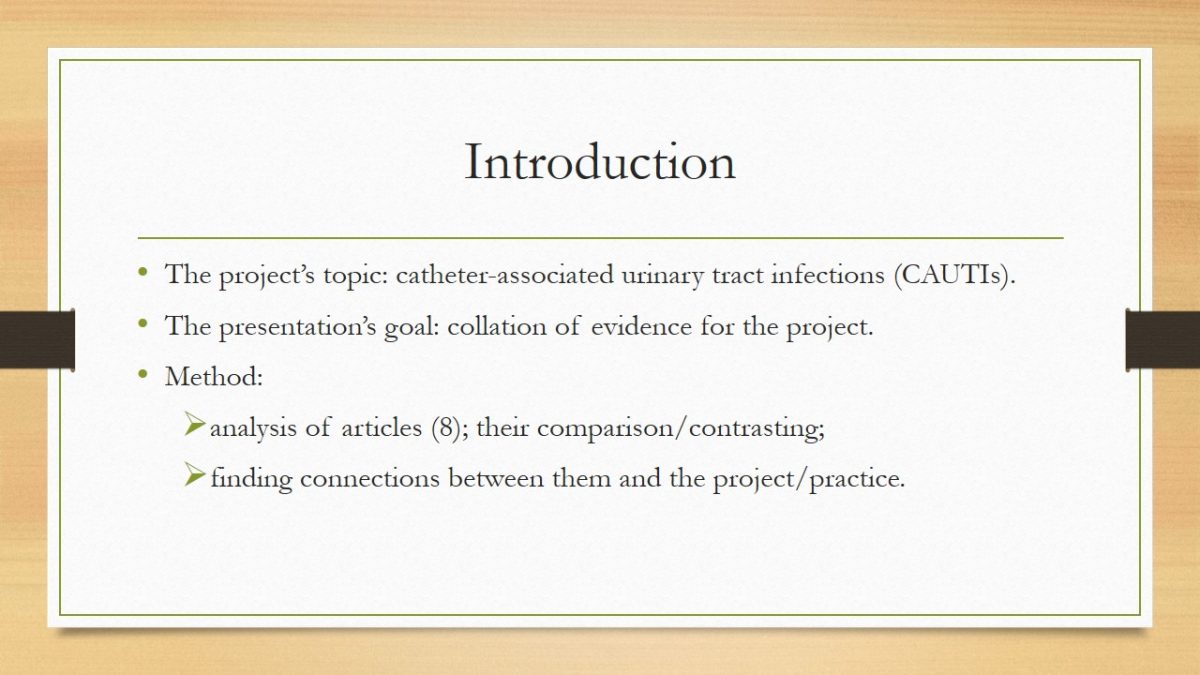
Topic Area: Quality Improvement Implementation
- Benchmarking: a tool for measuring quality and related progress (Garrard, Boyle, Simon, Dunton, & Gajewski, 2016).
- Leadership: motivation/organization of an effort/project (Gunawan & Aungsuroch, 2017).
- Communication/cooperation: effective interactions for a project that incorporates multiple actors (Wittenberg, Goldsmith, & Neiman, 2015)
The articles will all be united within the topic of quality improvement, but they are not very similar. In fact, they cover rather diverse areas, including benchmarking, leadership, and communication. However, it is apparent that these areas are connected to quality improvement. Thus, benchmarking is a tool for quality improvement, which is meant to measure the current quality of care and serve as a comparison for progress. Leadership and communication are also a form of instruments; in particular, they are required to organize a quality improvement project. This factor makes all these topics relevant to the current presentation since the CAUTI project is meant to improve the quality of care and patient safety by reducing CAUTIs.
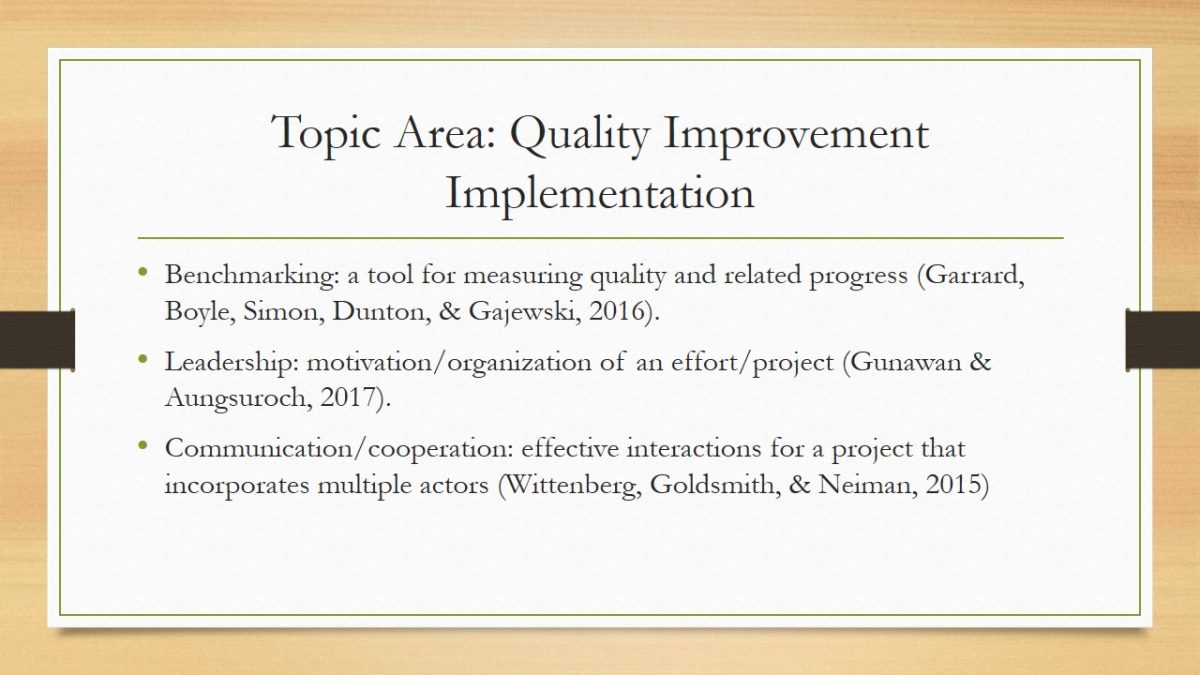
Question
For senior patients ages 65 years and above of long-term care facilities (P), how does the use of disposable washcloth with 2% chlorhexidine gluconate (I) compared to standard catheter care (C) affect the rate and prevalence of catheter-associated urinary tract infections (O) within a six-week period (T)?
Discussion questions: quality improvement (QI), benchmarking, leadership, communication, meaningful use (MU).
This slide contains the project’s PICOT question. In turn, the discussions covered a number of other important topics, including benchmarking and leadership, as well as communication. In addition to that, MU was also a topic that can be associated with QI. The articles that were employed to respond to the discussion questions were of use to the project and provided helpful insights into nursing quality and patient safety.
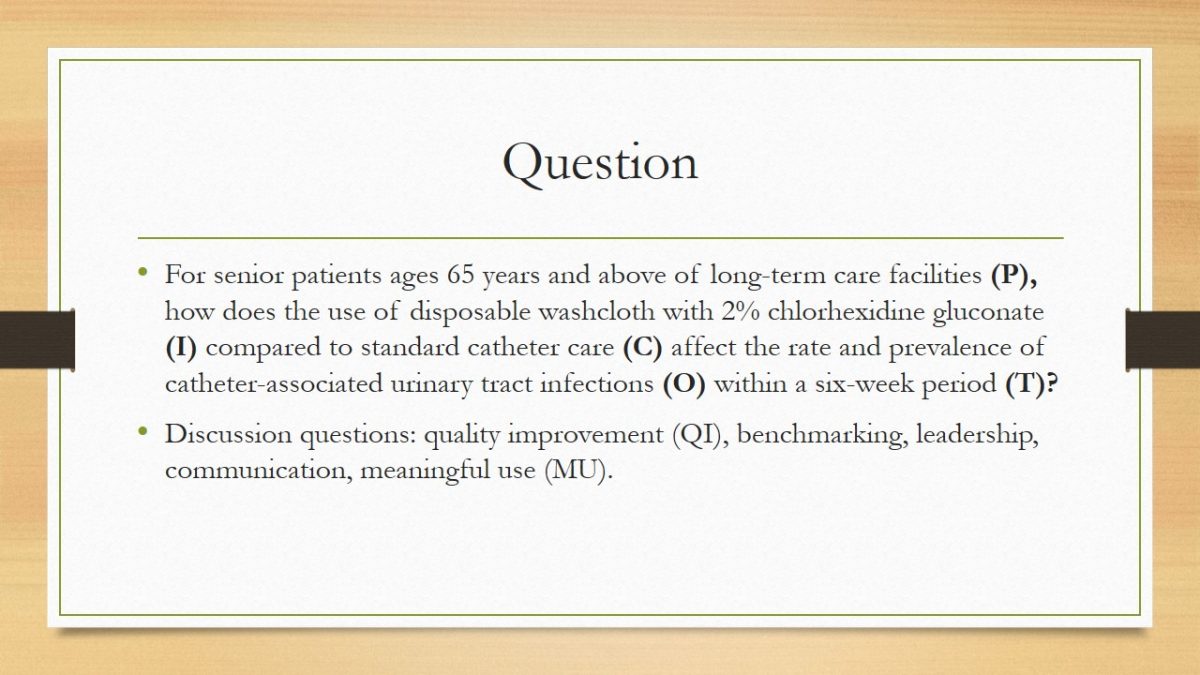
Significance
- Why are the tools required?
- QI needed for patient safety/quality of care.
- QI is complex; multiple barriers (Green et al., 2015; Tappen et al., 2017).
- Why should they be studied?
- Evidence-based solutions.
- Guidance for the project (future projects).
From this perspective, the significance of the topic area needs to be considered again. Thus, the described areas or tools are significant due to the significance of QI, which is necessary to ensure the continued progress of the quality of care, as well as patient safety. However, evidence and practice demonstrate that these outcomes are difficult to achieve; there are multiple barriers that complicate QI (Green et al., 2015; Tappen et al., 2017). As a result, the three tools, as well as their barriers and evidence-based solutions, need to be studied. Such information can help to guide the current or future projects.
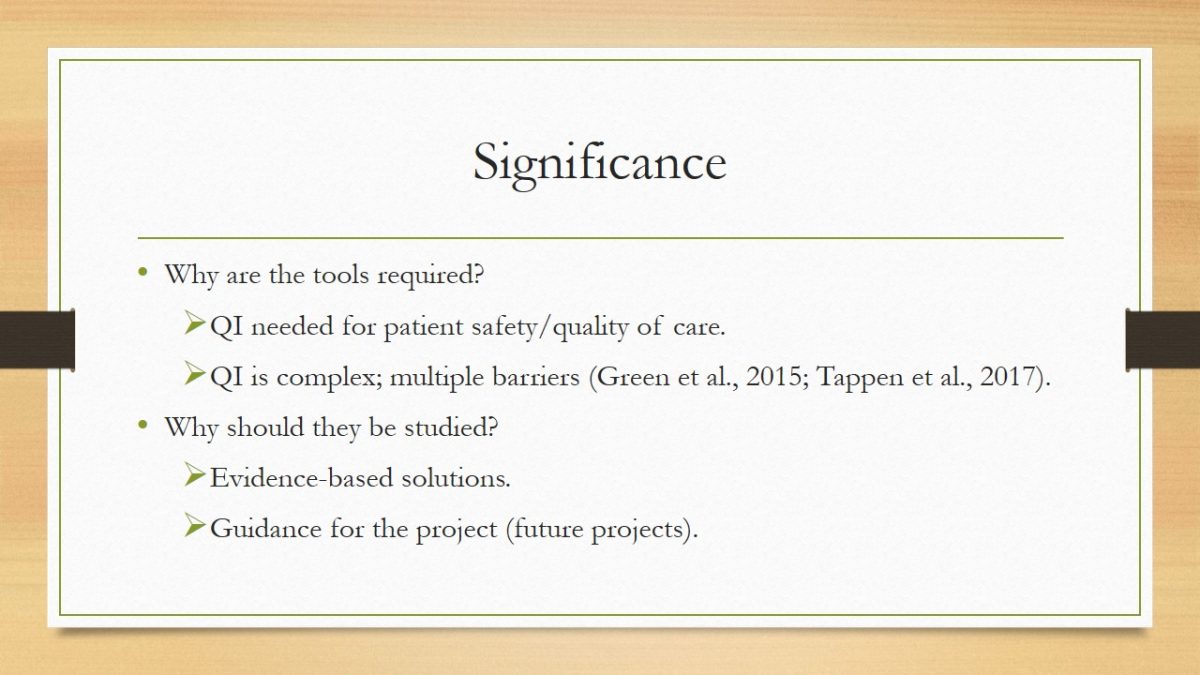
Overview of Clinical Practicum
- Research:
- Project implementation/data analysis; pre-test post-test for staff training and patients’ CAUTIs (determined with urinalysis); descriptive statistics and Wilcoxon signed ranks test.
- Clinical practice:
- Project-associated activities.
- Additional activities: working with patients.
The project needs to be described in greater detail. Its implementation phase has been finished; it involved the training of the staff to employ specific chlorhexidine washcloths that were tested for their ability to prevent or reduce the incidence of CAUTIs. The application of those washcloths was also a primary activity of the project. The final samples amounted to 26 staff members and four residents of a long-term care organization. The data collection was carried out before and after the project, and the results have already been analyzed. The project involved some clinical practice, especially as related to washcloths bathing, but other clinical activities also worked in support of it. The evidence collected over the past few weeks contributed some guidance to this project, and it can also be used for future ones.
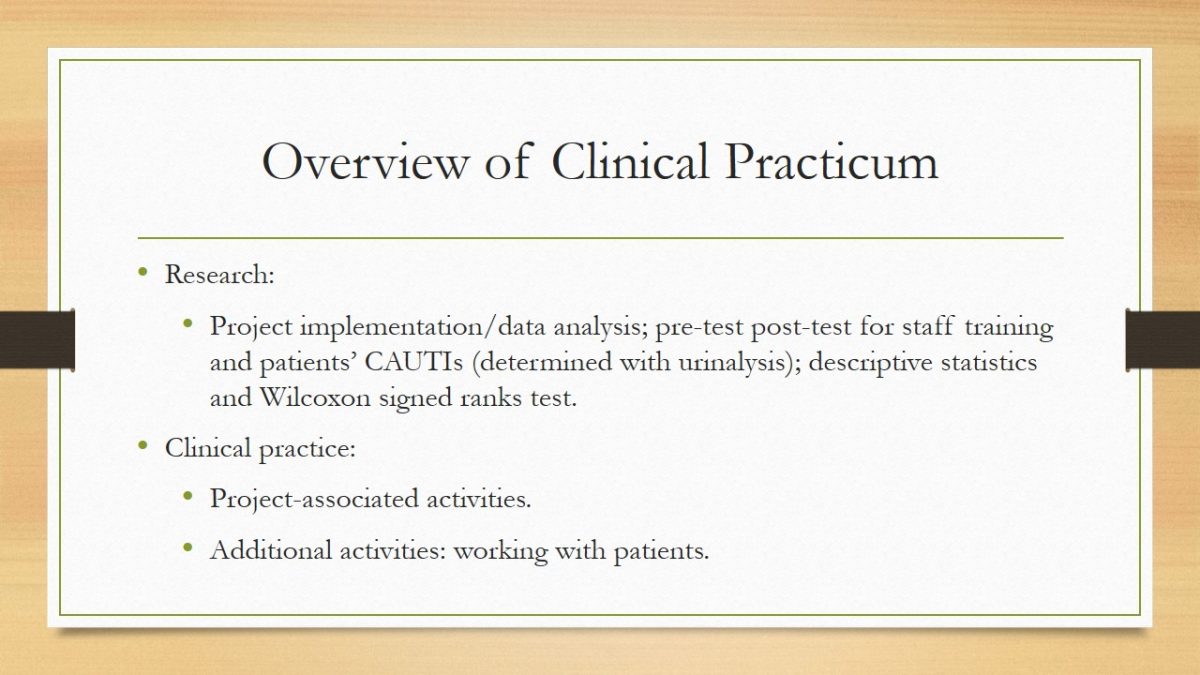
Analysis of Evidence: Quality Improvement
Tappen et al. (2017):
- Summary: qualitative (monthly phone interviews; one year); 71 nursing homes undergoing change (INTERACT model: training and specific tools).
- Conclusions: barriers (resources, resistance, competition, technical problems, bad leadership, and difficulty/magnitude of tasks) and facilitators (training, leadership, support, engagement, persistence, and focus on positive results).
First, the topic of QI was supported by the articles. The article that was dedicated to it was that by Tappen et al. (2017). It is a qualitative interview-based study that involved the representatives of 71 nursing homes which were in the process of change. They reported multiple barriers, including those related to resource shortages and technical problems, as well as ineffective leadership. However, they also commented on facilitators, including effective leadership and staff engagement. Due to its carefully crafted methodology and large sample, the article can offer some guidance on how to implement quality improvement projects.
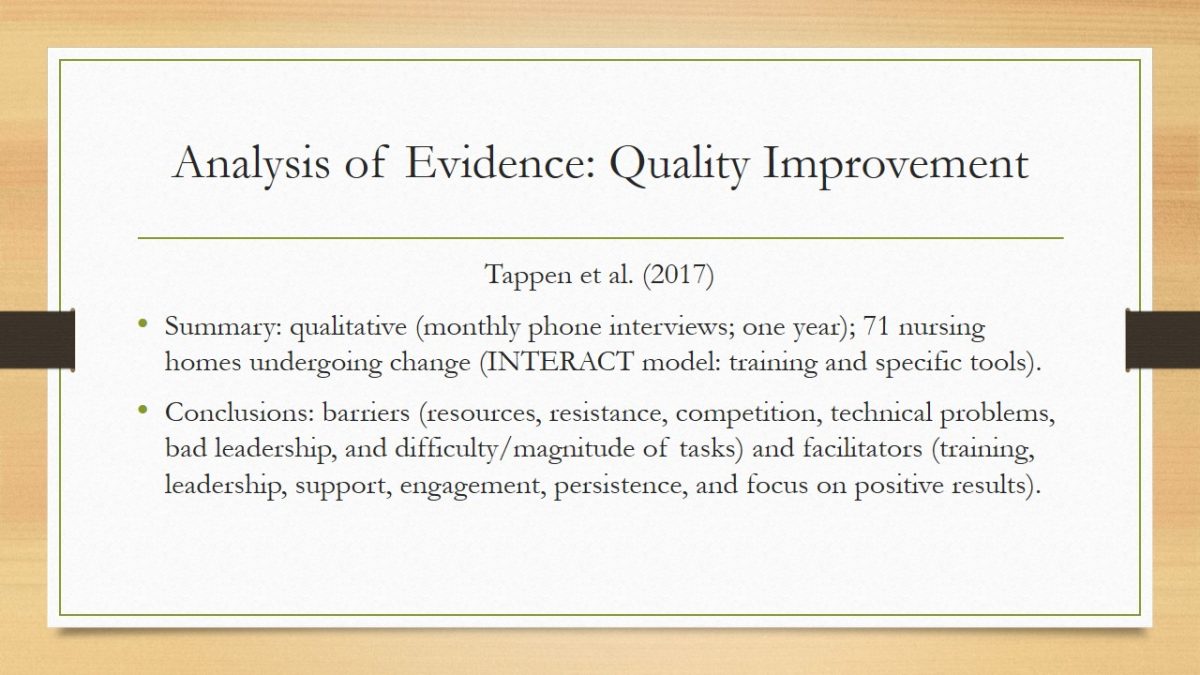
Quality Improvement: Benchmarking
Garrard et al. (2016):
- Summary: evaluating the National Database of Nursing Quality Indicators (specifically, falls) for validity/reliability (over 1159 sites).
- Conclusion: sufficiently valid and reliable.
The topic of benchmarking was covered in the article by Garrard et al. (2016). The authors evaluated the falls-related indicators from the National Database of Nursing Quality; they had a very impressive amount of data gathered from over a thousand sites. Garrard et al. (2016) also employed reliable statistical tests to determine the ability of the indicator to produce consistent and reliable results. Their conclusion was that the indicator could be used, which supports the idea of utilizing benchmarking tools like the Database for quality improvement projects. This information can be very helpful in future research.
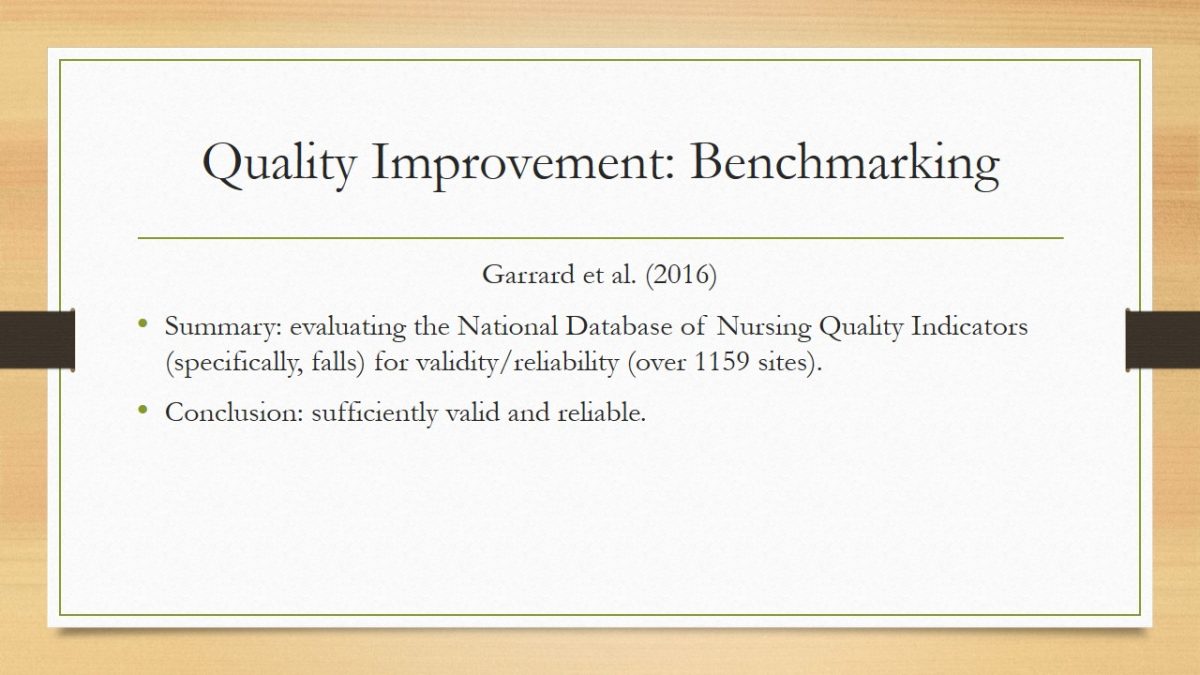
Meaningful Use
Green et al. (2015):
- Summary: interviews (3 facilities and 6 specialists) on MU implementation.
- Conclusions: barriers (lack of resources and expertise; problems in rural areas; the need for technical support, leadership, and management; the complexity of ongoing support for maintenance).
Green et al. (2015) investigated MU, and they employed multiple interviews from three sites to determine the specifics of MU implementation. Their findings focused on the barriers, which included resource- and expertise-related shortages, as well as the demand for effective leadership and management. The authors also highlighted the difficulty of maintaining MU and the exacerbation of the barriers in rural areas. The findings are of use for any project, even if it is not related to MU, and they are in line with the information offered by Tappen et al. (2017).
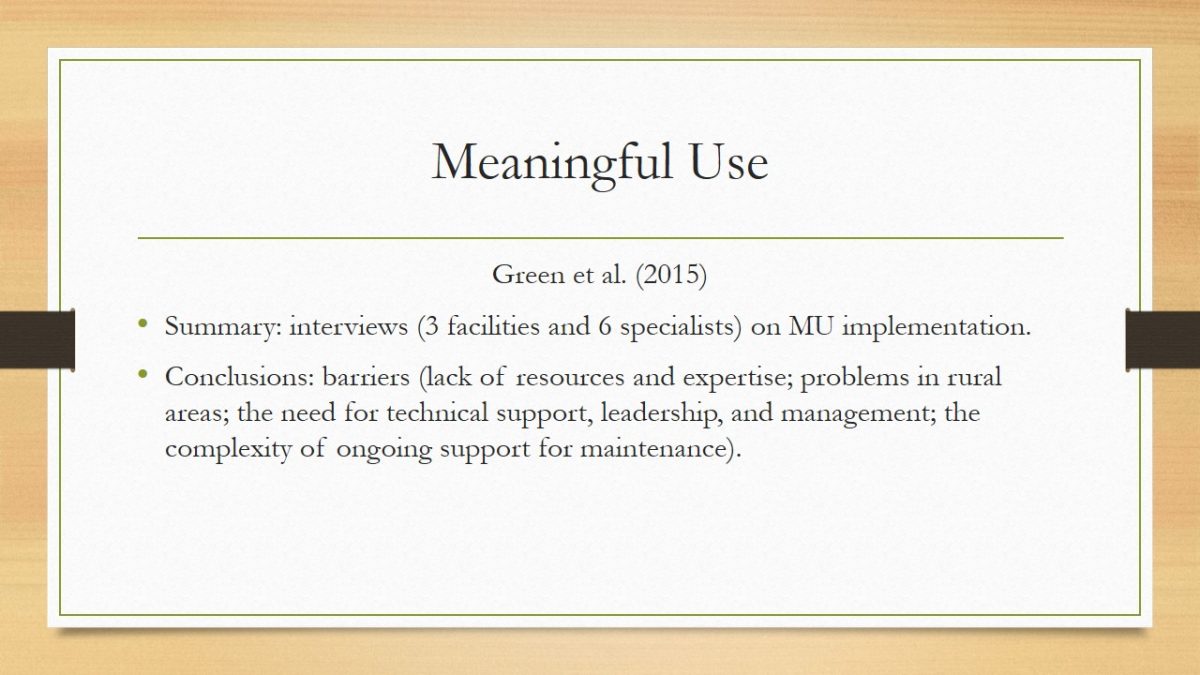
Meaningful Use and Leadership
- Slight et al. (2015):
- Summary: qualitative (interviews); 35 MU stakeholders.
- Conclusions: limitations (low-quality/missing tools and norms) barriers (resources, training; issues for rural communities).
- Montalvo (2015):
- Summary: a review of 38 articles.
- Conclusions: political skills facilitate managerial tasks and career advancement; not enough research.
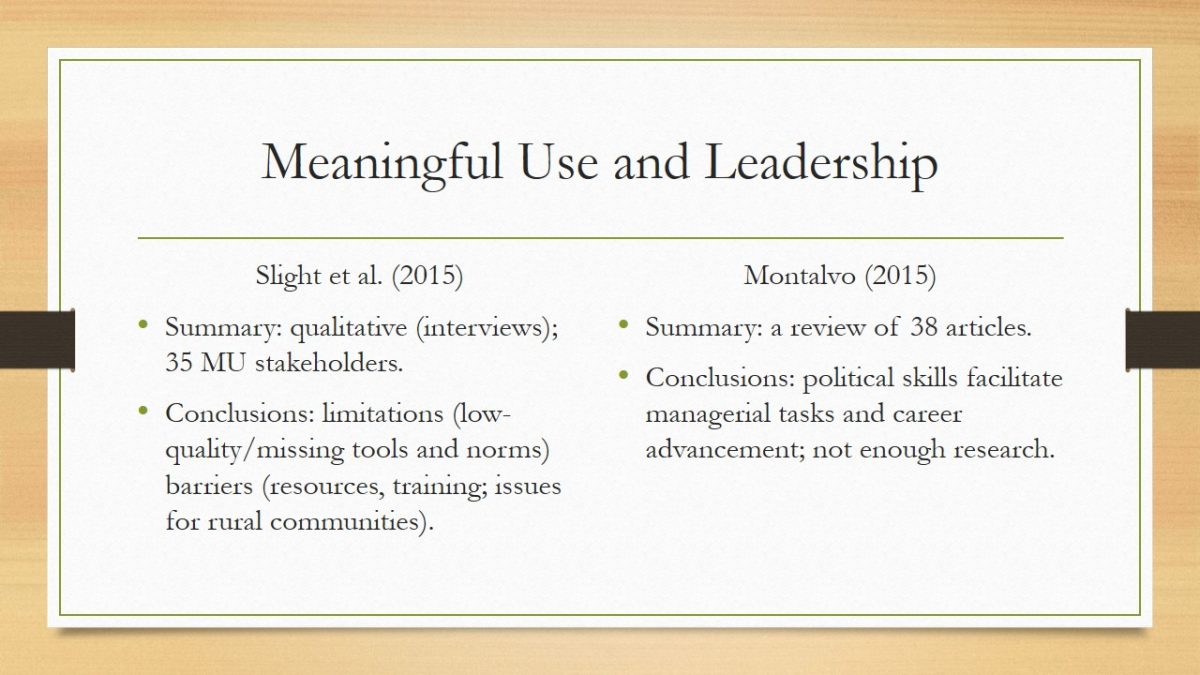
Leadership
Gunawan and Aungsuroch (2017):
- Summary: analysis of the concept of “managerial competence” in nursing; non-systematic literature review.
- Conclusions: constituents (planning, organizing, leading, ethics and legal issues, budgeting, self-development, and care); not enough research.
Gunawan and Aungsuroch (2017) also investigated leadership, but they viewed it as a part of managerial competencies in nursing. Their concept analysis involved a literature review, although there is little evidence to it being systematic, which is a limitation. Still, the findings demonstrate that there are multiple competencies that a nurse in a position of leadership needs to develop, including those related to planning, budgeting, and legal knowledge. Again, the information would be helpful for a leader of a quality improvement project.
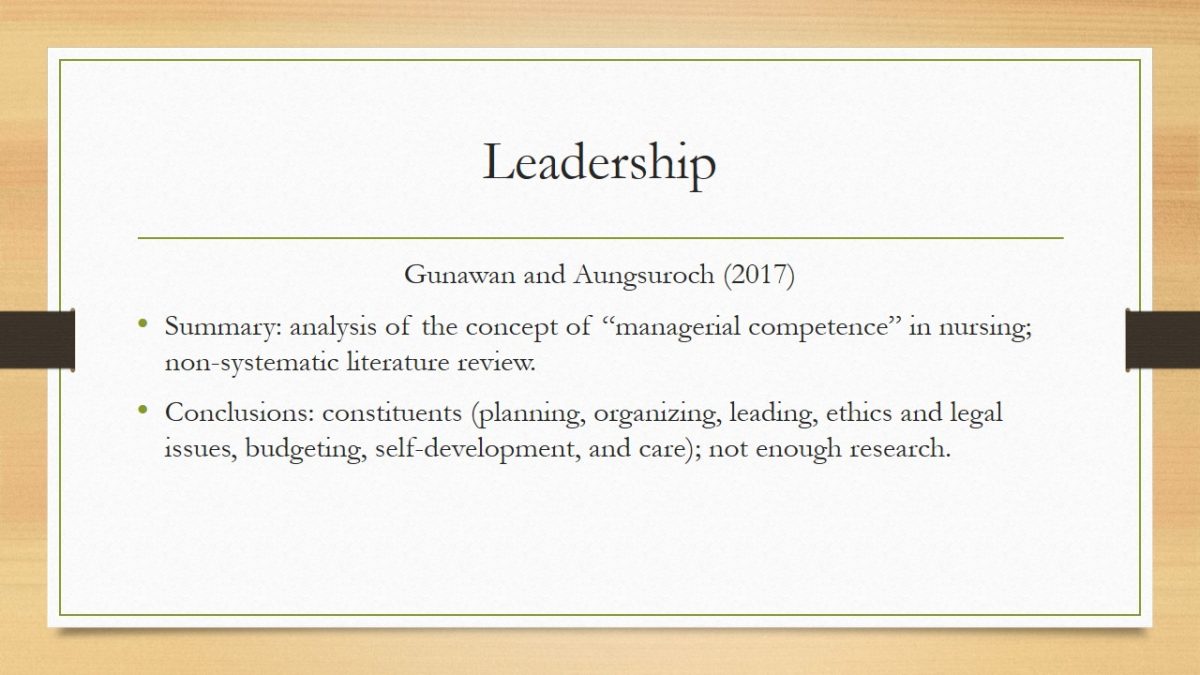
Communication
- Foronda, MacWilliams, and McArthur (2016);
- Summary: integrative literature review.
- Conclusions: miscommunication results from differences in training/perspectives/communication styles, bad organization, hierarchies, confidence, and ego. Solution: training/education, simulations.
- Wittenberg et al. (2015):
- Summary: quantitative survey; 193 American nurses (palliative care).
- Conclusions: the importance of relevant skills; difficulties with conflict management and discussion of errors; lacking nurse leadership.
Foronda et al. (2016) investigated a topic that is related to leadership, that is, communication. Their literature review demonstrated that interprofessional relationships might be complicated by different viewpoints and training, as well as non-similar communication styles. Furthermore, ineffective organization and personal qualities could serve as barriers. The authors propose training as a solution, including simulation-assisted training, and this recommendation is of interest to a nurse involved in a project or any other team-based activity.
Finally, the article by Wittenberg et al. (2015) is interesting for the same reason; its survey of 193 American nurses shows the importance of communication skills. It also reports that palliative nurses might find conflict management and error discussions to be difficult and might experience a lack of nursing leadership. These findings are only applicable to palliative nurses from the US, but they provide some information about the potentially difficult areas in communication in any case.
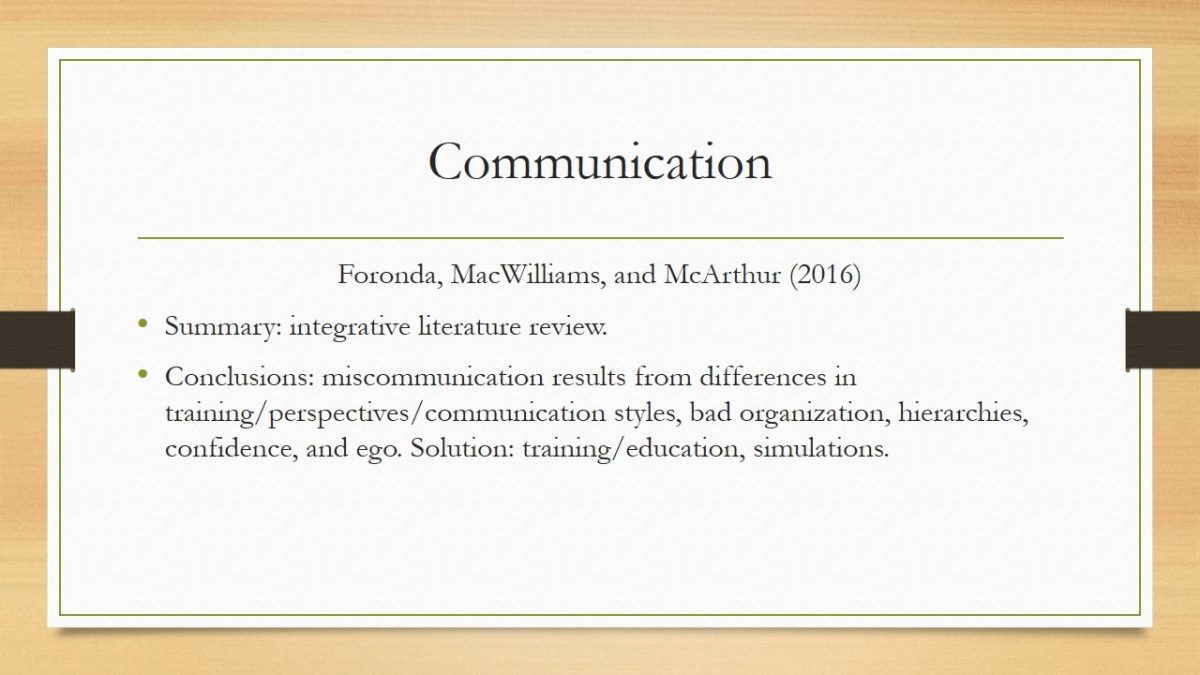
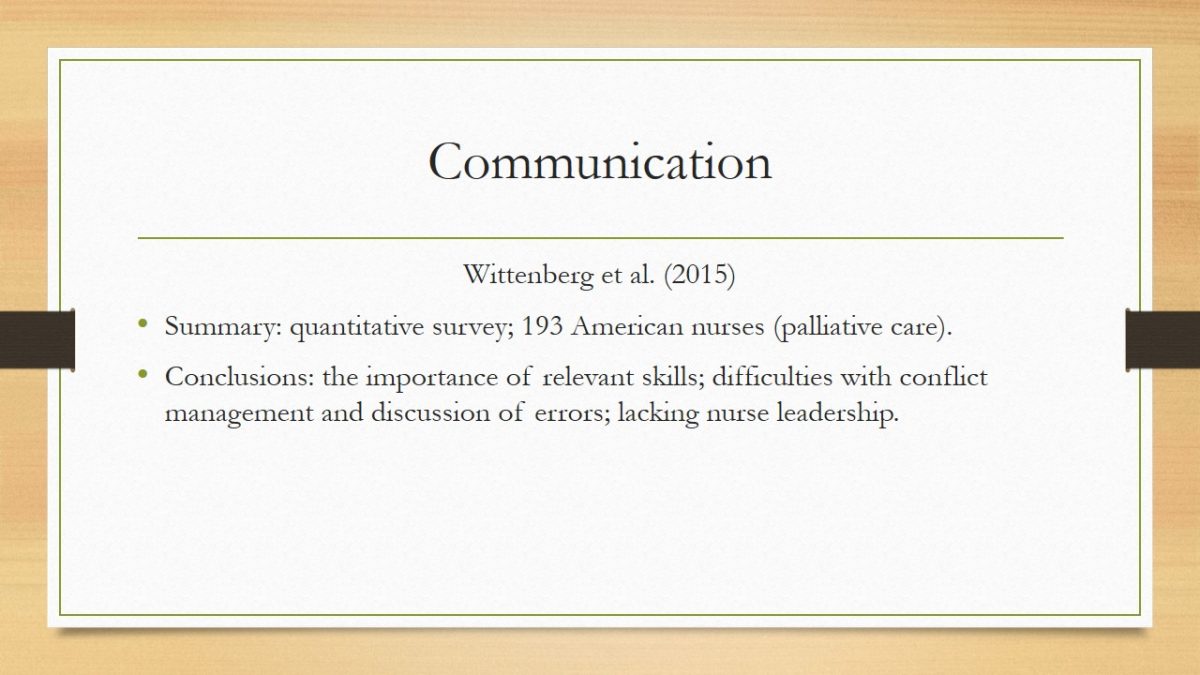
Comparison
- Differences: content and methods (concept analysis to literature reviews).
- Inconsistencies: none; some articles have similar findings.
- Strength: large samples; except for Gunawan and Aungsuroch (2017) – systematic search for literature; high-quality, peer-reviewed.
- Limitations: narrow focus (e.g., only palliative/American nurses); methodology limitations.
The presented articles are rather diverse; they are different in content, which is the result of them covering a variety of topics, and they tend to have different methodologies, although this presentation mostly involved qualitative articles or literature reviews with few exceptions. No inconsistencies were found; the articles dedicated to similar topics showed similarities if they covered related areas within those topics. The methodologies of the articles were fairly well-developed, and the ones that had samples tended to have relatively large ones. Still, they had their limitations, including their often narrow focus or not very generalizable findings.
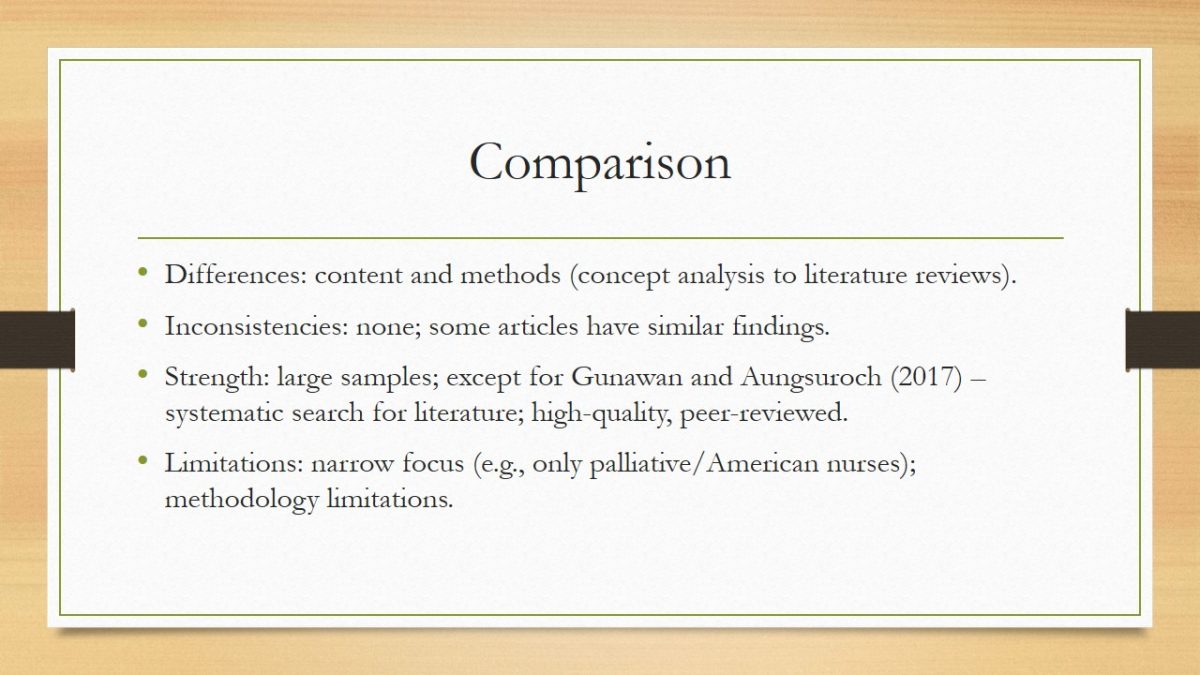
Implications and Use
- Key findings for use (project-related and other; relevant for quality/safety):
- project barriers/needs/requirements (resources, leadership, engagement);
- leadership/management skills;
- communication aspects/barriers/recommendations;
- quality improvement aspects (benchmarking, technology use).
- Methodology examples.
Still, the articles’ value for the project is apparent. First of all, their content is important; it provides information, as well as direct advice and recommendations in some cases, that is related to project barriers and requirements, leadership and communication skills, and various aspects of quality improvement. These data can be of use for any leader, which is why the knowledge is applicable to future projects as well. The presented areas are also connected to the activities that can help a nurse to advance quality and safety in their facility, which is another advantage of this presentation. Furthermore, the analysis of the methodology of the articles could assist in developing the methodology of the project.
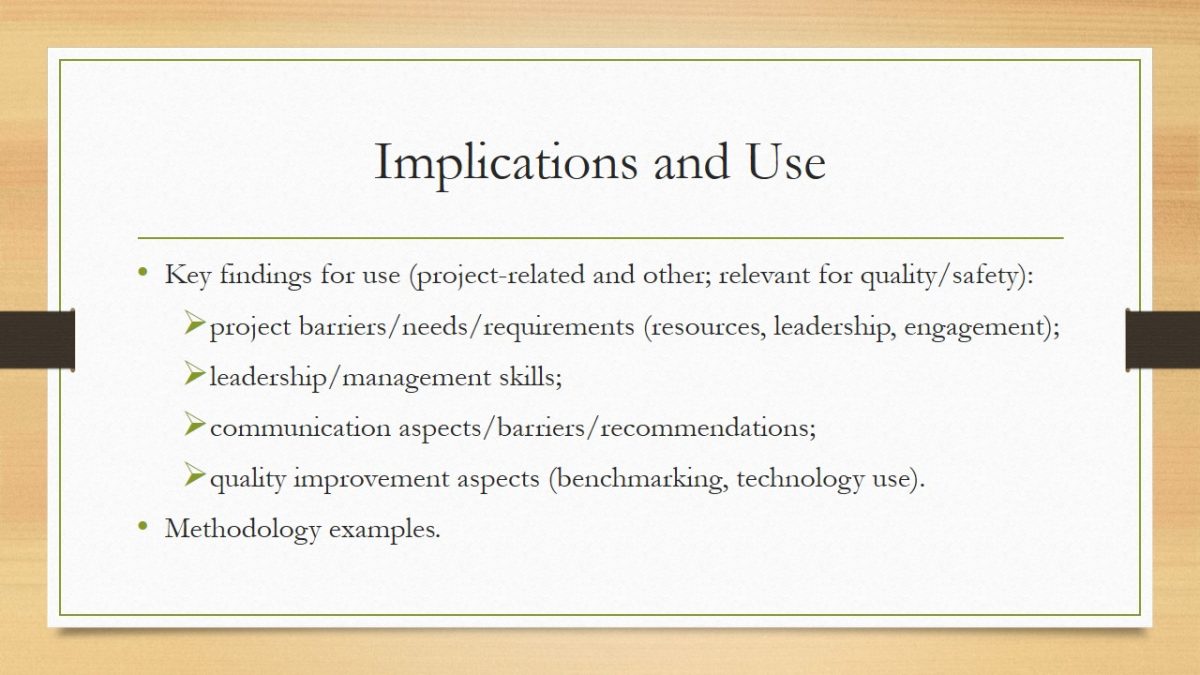
Next Steps
- Findings’ and lessons’ application to the project.
- Finalizing the project.
- Analyzing the project with the help of the articles/data from them.
- Developing related skills (especially leadership and communication).
- Applying the information/skills to future endeavors/projects.
Consequently, the following future steps can be considered. The presented findings, as well as the lessons that can be offered through their analysis, can and should be applied to the process of finalizing the project. In addition, the activities carried out throughout the project can be analyzed with the help of the findings; for example, it is possible to investigate the quality of leadership or the barriers to change that have been encountered. The presented data should also be employed for continued self-improvement, and future projects can be directed by them as well. To summarize, the evidence has been useful from multiple perspectives.
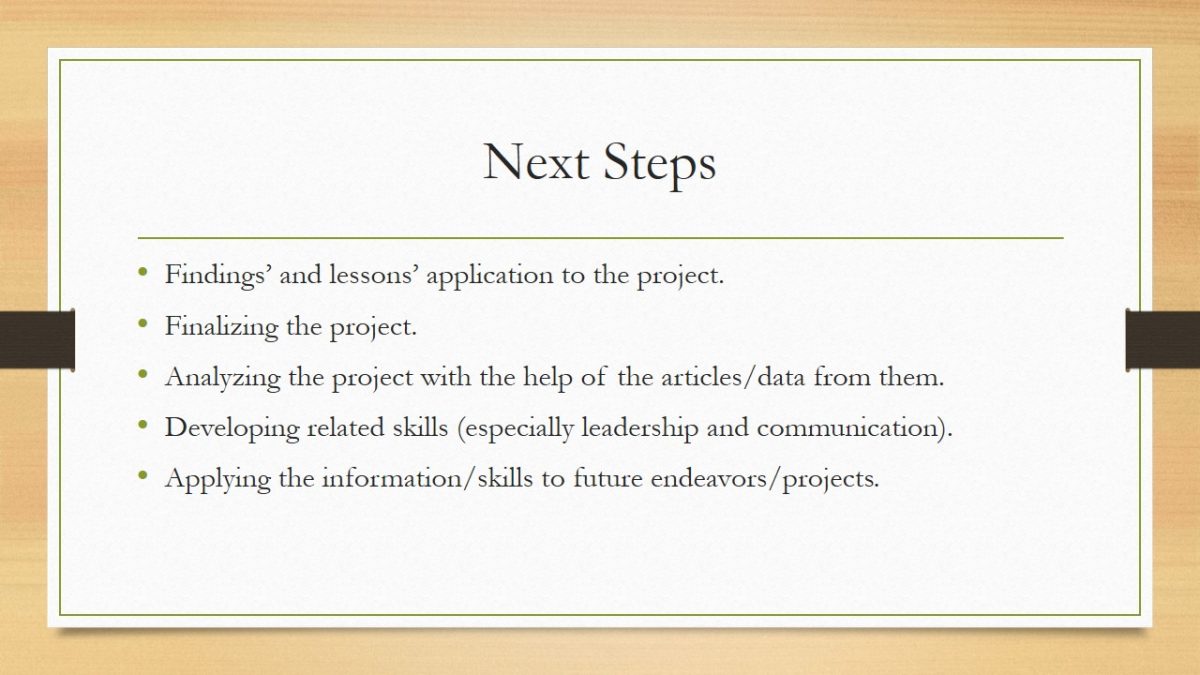
References
- Foronda, C., MacWilliams, B., & McArthur, E. (2016). Interprofessional communication in healthcare: An integrative review. Nurse Education in Practice, 19, 36-40. Web.
- Garrard, L., Boyle, D., Simon, M., Dunton, N., & Gajewski, B. (2016). Reliability and validity of the NDNQI® injury falls measure. Western Journal of Nursing Research, 38(1), 111-128. Web.
- Green, L., Potworowski, G., Day, A., May-Gentile, R., Vibbert, D., Maki, B., & Kiesel, L. (2015). Sustaining “meaningful use” of health information technology in low-resource practices. The Annals of Family Medicine, 13(1), 17-22. Web.
- Gunawan, J., & Aungsuroch, Y. (2017). Managerial competence of first-line nurse managers: A concept analysis. International Journal of Nursing Practice, 23(1), e12502. Web.
- Montalvo, W. (2015). Political skill and its relevance to nursing. JONA: The Journal of Nursing Administration, 45(7/8), 377-383. Web.
- Slight, S. P., Berner, E. S., Galanter, W., Huff, S., Lambert, B. L., Lannon, C., … Payne, T. H. (2015). Meaningful use of electronic health records: Experiences from the field and future opportunities. JMIR Medical Informatics, 3(3), e30. Web.
- Tappen, R., Wolf, D., Rahemi, Z., Engstrom, G., Rojido, C., Shutes, J., & Ouslander, J. (2017). Barriers and facilitators to implementing a change initiative in long-term care using the INTERACT® quality improvement program. The Health Care Manager, 36(3), 219-230. Web.
- Wittenberg, E., Goldsmith, J., & Neiman, T. (2015). Nurse-perceived communication challenges and roles on interprofessional care teams. Journal of Hospice & Palliative Nursing, 17(3), 257-262. Web.